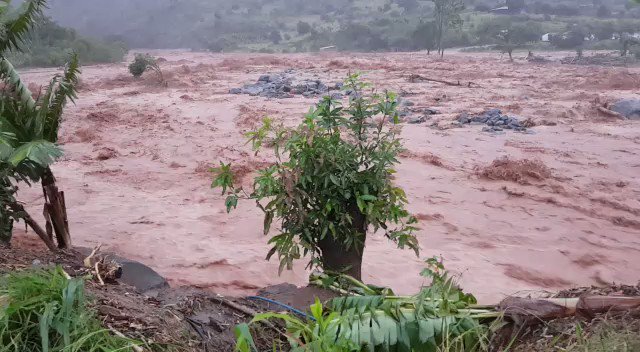
Rain from tropical cyclone Idai coming from central Mozambique, falls in the flooded districts of Chikwawa and Nsanje in southern Malawi. (Amos Gumulira, AFP)Today, 09:22 AMPublished Date: Today, 09:22 AM
The death toll from cyclone Idai continues to rise as southern African countries struggle to deal with the devastating aftermath of the torrential downpours.
The powerful storm has killed at least 90 people in Zimbabwe in recent days, government officials say, while in neighbouring Mozambique the death toll has jumped to 100.
Idai made landfall in Mozambique on Thursday evening before proceeding to Zimbabwe and Malawi, causing flash floods, wrecking infrastructure and leaving communities without electricity.
More than a million people have been affected, including tens of thousands who have been displaced, according to the International Federation of Red Cross and Red Crescent Societies.
In Zimbabwe’s Eastern Highlands, the heavy rains had died out by Sunday – but only after causing widespread destruction.
In Chipinge, an eastern town some 450km southeast of the capital, Harare, transport links were cut off after a road was damaged due to water pressure.


African Curators@AfricanCurators

Keep Zimbabwe in your prayers 73810:51 AM – Mar 17, 2019510 people are talking about thisTwitter Ads info and privacy
A bus carrying passengers bound for Harare was stuck in a mush of soft tar and mud. A few small cars managed to bypass the sludge when volunteers and soldiers laid down a makeshift path made of wooden planks.
Transport engineers told Al Jazeera that the works to repair the damaged road could take up to a day, leaving locals trying to leave the flooded town straned.
Gladys Nyandoro, a 58-year-old Chipinge resident whose home had been flooded, said she would seek alternative transport to continue her journey with her son to a temporary shelter in Harare.
“I could only leave with a few clothes, but my house is full of water. I have never seen so much rain since we moved back here,” she said of her husband’s communal home.
“I just want to go back to Harare; this area is too much for me.”
Anesu Chitepo, a 22-year-old shopkeeper, said his grocery store had been affected by erratic power outages caused by the heavy rains.
“We can’t be happy to think this rain is a blessing, when everything it touches is destroyed,” he said. “This will only bring us more trouble, than the real water we wanted.”


Sometimes when water is little we pray for more of it but it doesn’t come. Our crops die.
Sometimes when it decides to come, there’s too much of it. Our crops die.
In either case, our lives are shattered. Utter devastation.
This is what’s happening in #Zimbabwe
Please help1,1077:53 PM – Mar 16, 2019809 people are talking about thisTwitter Ads info and privacy
Zimbabwe’s government has declared the torrential storm a disaster and dispatched members of the military and national youth service to help evacuate stranded villagers.
Meanwhile, the country’s Civil Protection Unit has been using helicopters to gain access to the remote town of Chimanimani, on the northeastern border with Mozambique.
Local aid groups are yet access the area where dozens are thought to be missing and hundreds more are in urgent need of humanitarian aid.
According to Joshua Sacco, a local member of Parliament, all four bridges leading to the mountainous town have been damaged.
“We have people stranded in this area, but the access roads to this area have landslides,” he said.
“There is nothing, we don’t have any road accessible,” added Sacco.
“The best form of help we need is an excavator or a grader to clear the roads.”
The cyclone has brought torrential rains and winds thought to be worst in decades since Cyclone Eline struck the region in 2000.

